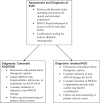Controversies in Assessment, Diagnosis, and Treatment of Kratom Use Disorder
- PMID: 39134892
- PMCID: PMC11344726
- DOI: 10.1007/s11920-024-01524-1
Controversies in Assessment, Diagnosis, and Treatment of Kratom Use Disorder
Abstract
Purpose of review: We apply the Diagnostic and Statistical Manual of Mental Disorders Fifth Edition (DSM-5) criteria for substance use disorders (SUDs) to the herbal product kratom. Similarities and differences between kratom use disorder (KUD) and other SUDs are explored, along with assessment, diagnostic, and therapeutic recommendations for KUD.
Recent findings: Literature reports of "kratom addiction" or KUD rarely specify the criteria by which patients were diagnosed. Individuals meeting DSM-5 KUD criteria typically do so via tolerance and withdrawal, using more than intended, and craving, not functional or psychosocial disruption, which occur rarely. Most clinicians who use medication to treat patients with isolated KUD select buprenorphine formulations, although there are no controlled studies showing that buprenorphine is safe or efficacious in this patient population. Diagnosis and treatment decisions for KUD should be systematic. We propose an algorithm that takes into consideration whether KUD occurs with comorbid opioid use disorder.
Keywords: Mitragyna speciosa addiction; DSM-5 diagnosis of substance use disorders; Kratom addiction; Kratom use disorder; Substance use disorder – other.
© 2024. This is a U.S. Government work and not under copyright protection in the US; foreign copyright protection may apply.
Conflict of interest statement
Drs. Weiss and Epstein report no conflicts of interest to disclose. Drs. Weiss and Epstein are funded by the Intramural Research Program of the National Institute on Drug Abuse, National Institutes of Health. In the past 36 months, Dr. Smith has served as a paid scientific advisor to the International Plant and Herbal Alliance and The Kratom Coalition, and serves as an expert witness in legal cases involving kratom. Dr. Smith is funded by NIDA grant R00DA055571.
Figures
References
-
- American Psychiatric Association, editor. Diagnostic and Statistical Manual of Mental Disorders. 5th ed. 2013. 10.1176/appi.books.9780890425596.
-
- World Health Organization. International Classification of Diseases. Eleventh Revision (ICD-11). 2021. https://icd.who.int/browse11.
-
- Hasin DS, Shmulewitz D, Stohl M, Greenstein E, Aharonovich E, Petronis KR, Von Korff M, Datta S, Sonty N, Ross S, Inturrisi C, Weinberger ML, Scodes J, Wall MM. Diagnosing prescription opioid use disorder in patients using prescribed opioids for chronic pain. Am J Psychiatry. 2022;179(10):715–25. 10.1176/appi.ajp.21070721. 10.1176/appi.ajp.21070721 - DOI - PubMed
Publication types
MeSH terms
Grants and funding
LinkOut - more resources
Full Text Sources
Medical
Research Materials


